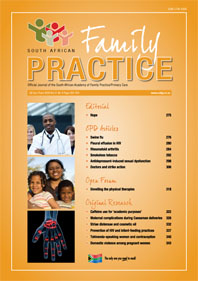Medical students' use of caffeine for academic purposes and their knowledge of its benefits, side-effects and withdrawal symptoms
Keywords:
caffeine, academic, knowledge, benefits, side-effects, withdrawal
Abstract
Background: Caffeine is often used for its benefits, which include increased vigilance. It has, however, side-effects like palpitations, and withdrawal symptoms including headaches and drowsiness. Tertiary education often requires students to study for extended hours, especially during periods of increased workload prior to tests and examinations. Medical students, who have to master a very large volume of academic work in a limited amount of time, are no exception. This cross-sectional study investigated caffeine use for academic purposes by first- to third-year medical students at the University of the Free State in 2006, and their knowledge of its benefits, side-effects and withdrawal symptoms. Methods: Data were collected by means of an anonymous, self-administered questionnaire completed by students during formal class time arranged in advance with the relevant lecturers. Questionnaires were available in Afrikaans and English. A pilot study was conducted on 20 physiotherapy students to test the questionnaire. Chi-squared and Kruskall-Wallis tests were used to compare categorical and numerical variables, respectively. Ethical approval to perform the investigation was granted by the Ethics Committee of the Faculty of Health Sciences, University of the Free State. Results: A 90.5% (360/389) response rate was obtained. Ninety-four percent of participants used caffeine, with "academic purposes" (62.6%) among the three most frequent reasons for its consumption. Other reasons included social consumption (70%) and preference for the taste (72.4%). Coffee (88.2%) was the most commonly consumed caffeinated product among these students, followed by energy mixtures and tablets (37.9%) and soft drinks (36%). Third-year students were the heaviest consumers of coffee for academic purposes. An increase in caffeine consumption for academic purpose was directly related to progression from first- to third- year of the medical course. The average scores for questions on benefits, side-effects and withdrawal symptoms were all below 1.5 out of 5. Misconceptions about caffeine were also identified. With regard to the benefits of caffeine, the most commonly cited misconception was that it could be used as a substitute for sleep (26.7% of respondents). The most common misconception regarding its side-effects was that it caused hot flushes (21.9%), while aggression (27.2%) was cited as the most common misconception regarding caffeine withdrawal. Conclusions: The high percentage of caffeine usage and low scores in the caffeine knowledge test indicated that most participants were using caffeine without having sufficient knowledge of its benefits, side-effects and withdrawal symptoms. It is recommended that awareness programmes on the side-effects and symptoms of caffeine withdrawal should be implemented by the students health and counseling facilities on campus. Display of posters in strategic venues and distribution of pamphlets could assist in the dissemination of information on this extensively consumed substance.
Published
2009-05-16
Section
Original Research
By submitting manuscripts to SAFP, authors of original articles are assigning copyright to the South African Academy of Family Physicians. Copyright of review articles are assigned to the Publisher, Medpharm Publications (Pty) Ltd, unless otherwise specified. Authors may use their own work after publication without written permission, provided they acknowledge the original source. Individuals and academic institutions may freely copy and distribute articles published in SAFP for educational and research purposes without obtaining permission.

